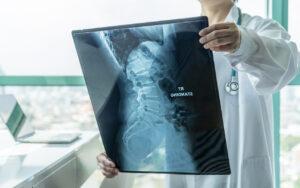
The World Health Organization estimates that 15 million people around the world are living with a spinal cord injury (SCI). The term “spinal cord injury” is used to describe any kind of damage to the spinal cord, including both traumatic and non-traumatic causes.
Living with a spinal cord injury can come with many social, medical, and financial challenges. Depending on the nature of the injury, an individual may need assistance 24 hours a day. This can seriously strain a family’s economic and personal resources.
Here’s what you need to know about these injuries and what you can do if you sustain one in an accident caused by someone else’s negligence in Colorado.
What Is a Spinal Cord Injury?

The spinal cord is a bundle of nerve fibers through which the brain communicates with the other nerves in your body. It is one of two components that make up the central nervous system. The other component is the brain. Think of the spinal cord as a cable that connects the command center — your brain — to the rest of the body.
When the spinal cord is damaged, whether by an organic illness or a catastrophic accident, it is no longer able to communicate effectively. The results of an SCI vary depending on the type and severity of the injury. Some spinal cord injuries can heal, and some cannot. When an injury is permanent, it may cause paralysis and other SCI symptoms.
Men tend to be affected by SCIs more frequently than women. Both are at risk for developing secondary conditions that can be as harmful to an individual’s well-being as the injury itself. Infection and respiratory difficulties are two examples of potentially life-threatening secondary conditions.
Types of SCIs
Spinal cord injuries are defined by location and severity. They can occur in the:
- Cervical spine, or above the shoulders
- Thoracic spine, or from the upper back to the navel
- Lumbar spine, or the lower back
- Sacral spine, or the section from the gluteus maximus to the tailbone
SCIs are diagnosed as either complete or incomplete. A complete injury affects all the nerves in the spinal cord, meaning that no messages can get through.
Depending on where the SCI occurs, a complete injury can result in paralysis. For example, a complete injury in the cervical spine will likely result in quadriplegia, which is paralysis from the neck down. A complete injury that occurs in the lumbar spine may cause paralysis of the legs.
On the other hand, an incomplete injury affects only some of the nerves in the spinal bundle, allowing certain messages to get through. Incomplete injuries can cause many complications, including weakness in the limbs and sensory effects.
What Complications Are Associated With Spinal Cord Injuries?
SCIs can cause severe complications, some of which require lifelong medical care. Many people think of paralysis when they hear about a spinal cord injury. While tetraplegia, also known as quadriplegia, and paraplegia are two common complications of an injury to the spine, they are not the only complications SCIs can cause.
Blood Clots
When SCIs cause mobility issues, the lack of movement can lead to circulatory problems and increase the risk of blood clots. Blood clots can be treated when diagnosed in time. When left untreated, a blood clot can block the flow of blood to vital organs, potentially causing a stroke or heart attack.
Pneumonia
People with spinal cord injuries may have an increased risk of contracting pneumonia and other respiratory tract infections. Weakened chest and abdominal muscles limit the ability to take deep breaths or produce a cough that can help clear lungs naturally.
Healthy people can typically recover from pneumonia, but pneumonia can be a life-threatening infection for those with a compromised immune system.
Autonomic Dysreflexia
Autonomic dysreflexia (AD) is a life-threatening condition that occurs when a person’s autonomic nervous system overreacts to painful sensory input. AD can happen when a spinal cord injury occurs at or above the sixth thoracic vertebra. The main warning sign of AD is a severe and sudden rise in blood pressure, especially when accompanied by a headache.
Neurogenic and Spinal Shock
Neurogenic shock affects the body’s ability to regulate blood pressure, heart rate, and temperature due to damage to the nervous system. Spinal shock is similar to neurogenic shock but includes limp or weak muscles and an absence of reflexes due to the SCI.
Neuropathic Pain
Neuropathic — or nerve — pain can be mild or severe. While not life-threatening, nerve pain can decrease life quality. Chronic nerve pain may lead to mental health concerns like depression and anxiety.
What Causes Spinal Cord Injuries?
There are many common causes of an SCI, such as:
- Motor vehicle accidents, which account for more than 37% of SCIs
- Falls, which include falls at the workplace and slip and fall accidents
- Assault/violence, which accounts for around 15% of all SCIs
- Sports injuries
- Spinal tumors, including cancerous tumors
- Osteopenia and osteoporosis
- Ischemia or lack of blood flow to the spinal cord
- Infections of or around the spinal cord
- Fluid-filled cysts in the cavities of the spinal cord
- Autoimmune conditions like multiple sclerosis
- Congenital conditions like spina bifida
- Genetic conditions like hereditary spastic paraplegia
- Electrical shock
In most cases, trauma that is serious enough to damage the spinal cord will require emergency medical care. However, it is possible to damage the spinal cord without realizing the seriousness of the trauma.
If you experience weakness, numbness, tingling, or loss of control in any part of your body or have extreme back pain after an accident, seek medical care immediately. Delaying treatment could result in more severe damage and complications.
Long-Term Treatment For Spinal Cord Injuries
Some SCIs heal, allowing the injured person to return to full or almost full function. Other spinal injuries result in partial or total paralysis that may require extensive medical care for the rest of the individual’s life. Examples of long-term care include speech therapy, physical therapy, occupational therapy, and mental healthcare.
People with severe and complete SCIs may need in-home support services that assist with daily living tasks and medical care. As a result, the costs related to living with a spinal cord injury can be astronomical. The injured person may qualify to receive disability benefits to help meet their care needs, but such a severe injury can emotionally and financially devastate their family.
In Colorado, if an accident was caused by another person’s negligence, the injured party may be entitled to financial compensation.
Finding Help After Sustaining a Spinal Cord Injury in Colorado
Recovering from a spinal cord injury can be a long road. It takes a strong support team of medical professionals, friends, family members, and legal advisors to provide all the resources needed to maintain your health.
If you’ve been injured in an accident that wasn’t your fault, you may be entitled to compensation. The experienced spinal cord injury attorneys at Matos Personal Injury Lawyers have recovered millions for injured clients in Lakewood and beyond. Call us to learn more about your legal options today.
